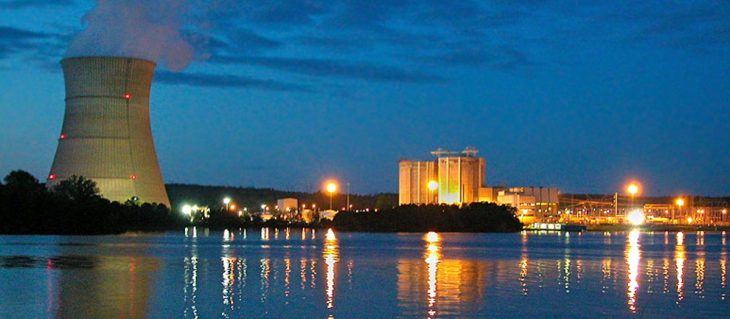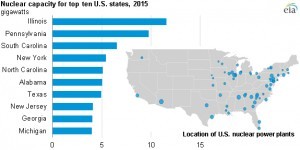U.S. nuclear power generation expected to rise despite recent plant closures
by November 25, 2015 12:21 pm 486 views

Entergy's Arkansas Nuclear One power plant in Russellville, Ark. (photo from Entergy)
Despite Entergy Corp.’s recent announcement that its plans to take more than 2,000 megawatts (MW) of nuclear generating capacity off the grid by 2019, total U.S. nuclear capacity will increase by 5,000 megawatts over the next five years, the U.S. Energy Information Administration said in a recent report.
The report followed the Nov. 2 surprise announcement by New Orleans-based Entergy Corp. that it plans to close the James A. FitzPatrick Nuclear Power Plant in Scriba, New York in late 2016 or early 2017. Entergy officials cited a number of factors in its decision to shutter the facility, including the continued deteriorating economics of the plant, high operational costs, a significant reduction in plant revenues due to low natural gas prices, and a poor market design that fails to properly compensate nuclear generators like FitzPatrick for its benefits.
The move by the parent company Entergy Arkansas ahead of its disappointing third quarter financial report was largely unexpected after the New Orleans utility operator had earlier announced on Oct. 13 it would close its Pilgrim Nuclear Power Station in Plymouth, Mass., by the summer of 2019, citing the many of the same reasons for closure as the FitzPatrick plant.
“Given the financial challenges our merchant power plants face from sustained wholesale power price declines and other unfavorable market conditions, we have been assessing each asset,” said Entergy Chairman and CEO Leo Denault. “As part of this review, we previously announced the closure of the Pilgrim Nuclear Generating Station in Massachusetts and have now decided that despite good operational performance, market conditions require us to also close the FitzPatrick nuclear plant.”
OTHER NUKE PLANT CLOSURES
In additional to the planned retirement of FitzPatrick and Pilgrim, Entergy’s Vermont Yankee Nuclear Power Station completed its 30th and final operating cycle at 12:12 p.m. on Dec. 29, 2014. That 620-megawatt plant, which supplied nearly one-third of all of Vermont’s electricity, had been in commercial operation since 1972.
Now faced with the huge and expensive task of decommissioning two other aging nuclear facilities, Entergy says it is still committed to its remaining fleet of five wholesale and company owned nuclear plants – including the sprawling Arkansas Nuclear One facility in Russellville that began operation in 1974.
“We recognize the consequences of the shutdown for our employees and the surrounding community and pledge to do our best to support both during this transition. As a company, we are committed to ensuring the well-being of our employees, and appreciate their continued dedication to making safe, clean, secure and reliable operations a top priority,” Denault said.
Besides the Entergy plants, one other East Coast nuclear power plant is expected to be decommissioned after utility giant Exelon announced in 2010 it would retire its Oyster Creek Generating Station on the New Jersey shore by the end of 2019. That 645-megawatt plant began operating as the first large-scale the nation’s first commercial nuclear power plant in December 1969.
PLANTS ON CONSTRUCTION LIST, SIX UNDER REVIEW
Still, according to the EIA, there are five new nuclear reactors now under construction in the U.S. that will add more 5,000 MW of capacity between 2016 and 2020 that will more than adequately replace the 2,000 megawatts of lost nuclear generation capacity that goes off line at the end of 2019.

Last month, the U.S. Nuclear Regulatory Commission issued the Tennessee Valley Authority (TVA) a 40-year operating license for Watts Bar Unit 2 in Spring City, Tenn., the first U.S. reactor to operate since 1996 when the agency issued the license for Watts Bar Unit 1. The Watts Bar 2 decision means there are now 100 commercial reactors licensed to operate in the U.S., according to the most recent tabs by the NRC and EIA.
The decision to bring Watts Bar Unit 2 online by 2016, TVA will add 2,300 megawatts of nuclear generation to its massive grid system that spans across the states of Tennessee, Alabama, Georgia, Kentucky, Mississippi, North Carolina and Virginia. Once in full operation, the Watts Bar Unit 1 and 2 will produce enough nuclear energy to power 1.3 million homes across TVA’s footprint.
“Completing Watts Bar Unit 2 was a sound business decision made for the long-term good of the Tennessee Valley,” TVA President and CEO Bill Johnson said at the Oct. 22 christening of the nuclear facility. “The unit is essential to diversifying TVA’s power sources to assure the more than 9 million people served by TVA and its local power company partners have affordable and reliable electricity generated in an environmentally friendly manner.”
Together with the Watts Bar facility, there are five new reactors under construction in the U.S., the EIA said. The Vogtle plant in eastern Georgia and the Virgil C. Summer plant in South Carolina, which have both experienced project delays of two to three years, are each scheduled to begin operating two new reactors in 2019 and 2020. Both facilities each have nearly 1200 megawatts of nuclear generating capacity.
In May, the NRC also approved a construction and operating license for DTW Energy’s Fermi Unit outside of Detroit, Mich. The new nuclear energy facility is planned for a site next to the existing Fermi 2 Nuclear Power Plant in Newport, Mich., although DTE officials have not fully committed to building the new nuclear plant out of fears continued low natural gas prices could make the facility obsolete by the time it is added to the grid.
“With this license, DTE Energy now possesses the most diverse, comprehensive slate of options to plan for Michigan’s energy future,” DTE President and CEO Steven Kurmas said of the planned 1,140 megawatt facility. “The potential of additional nuclear energy gives us the option of reliable, base-load, generation that does not emit greenhouse gases.”
In additional to the slate of nuclear plants that have received construction and operating licenses from the NRC, there are another half-dozen plants whose applications are under review by the regulatory panel. Also, in September, the NRS accepted Entergy’s request to have its Grand Gulf Nuclear Station Unit 3 in Port Gibson, Miss., withdrawn from the docket after years of project delays and construction costs overruns.
Today, 30 U.S. states have nuclear power plants with most located east of the Mississippi River. Illinois has the most nuclear capacity of any state, followed by Pennsylvania. Exelon, the utility with the highest amount of nuclear power capacity in its generation assets, operates 17 reactors at 10 plants located in Illinois, Pennsylvania, and New Jersey.
The nation’s largest nuclear plant and second-largest power plant of any fuel type is the Palo Verde Nuclear Generating Station in Arizona, which has three reactors with a total capacity of 3,937 megawatts. The 479-megawatt Fort Calhoun Nuclear Generating Station in Nebraska is the nation’s smallest nuclear plant in operation.
